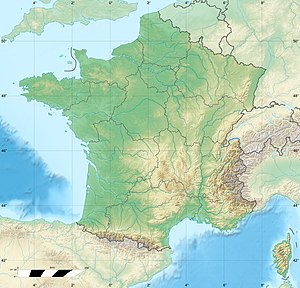
Back Emgann Montereau Breton Schlacht bei Montereau German Bataille de Montereau French Montereau-i csata Hungarian Battaglia di Montereau Italian Battaja de Montereau LMO Slaget ved Montereau NB Bitwa pod Montereau Polish Сражение при Монтро Russian 蒙特羅戰役 Chinese
| Battle of Montereau | |||||||
|---|---|---|---|---|---|---|---|
| Part of the Campaign of France of the Sixth Coalition | |||||||
 Battle of Montereau, 18 February 1814 by Jean-Charles Langlois (1840) | |||||||
| |||||||
| Belligerents | |||||||
|
|
| ||||||
| Commanders and leaders | |||||||
|
|
| ||||||
| Strength | |||||||
|
30,000[1] 70–80 guns |
15,000[1]–18,000 40 guns | ||||||
| Casualties and losses | |||||||
| 2,000[1]–3,000 killed, wounded, or captured |
5,000[1]–6,000 killed, wounded, or captured 2–15 guns lost | ||||||
Location within France | |||||||
The Battle of Montereau (18 February 1814) was fought during the War of the Sixth Coalition between an Imperial French army led by Emperor Napoleon and a corps of Austrians and Württembergers commanded by Crown Prince Frederick William of Württemberg. While Napoleon's army mauled an Allied army under Gebhard Leberecht von Blücher, the main Allied army commanded by Karl Philipp, Prince of Schwarzenberg, advanced to a position dangerously close to Paris. Gathering up his outnumbered forces, Napoleon rushed his soldiers south to deal with Schwarzenberg. Hearing of the approach of the French emperor, the Allied commander ordered a withdrawal, but on 17 February saw his rear guards overrun or brushed aside.
Ordered to hold Montereau until nightfall on 18 February, the Crown Prince of Württemberg posted a strong force on the north bank of the Seine River. All morning and past noon, the Allies stoutly held off a series of French attacks. However, under increasing French pressure, the Crown Prince's lines buckled in the afternoon and his troops ran for the single bridge to their rear. Brilliantly led by Pierre Claude Pajol, the French cavalry got among the fugitives, captured the spans over both the Seine and Yonne Rivers and seized Montereau. The Allied force suffered heavy losses, and the defeat confirmed Schwarzenberg's decision to continue the retreat to Troyes.
© MMXXIII Rich X Search. We shall prevail. All rights reserved. Rich X Search

